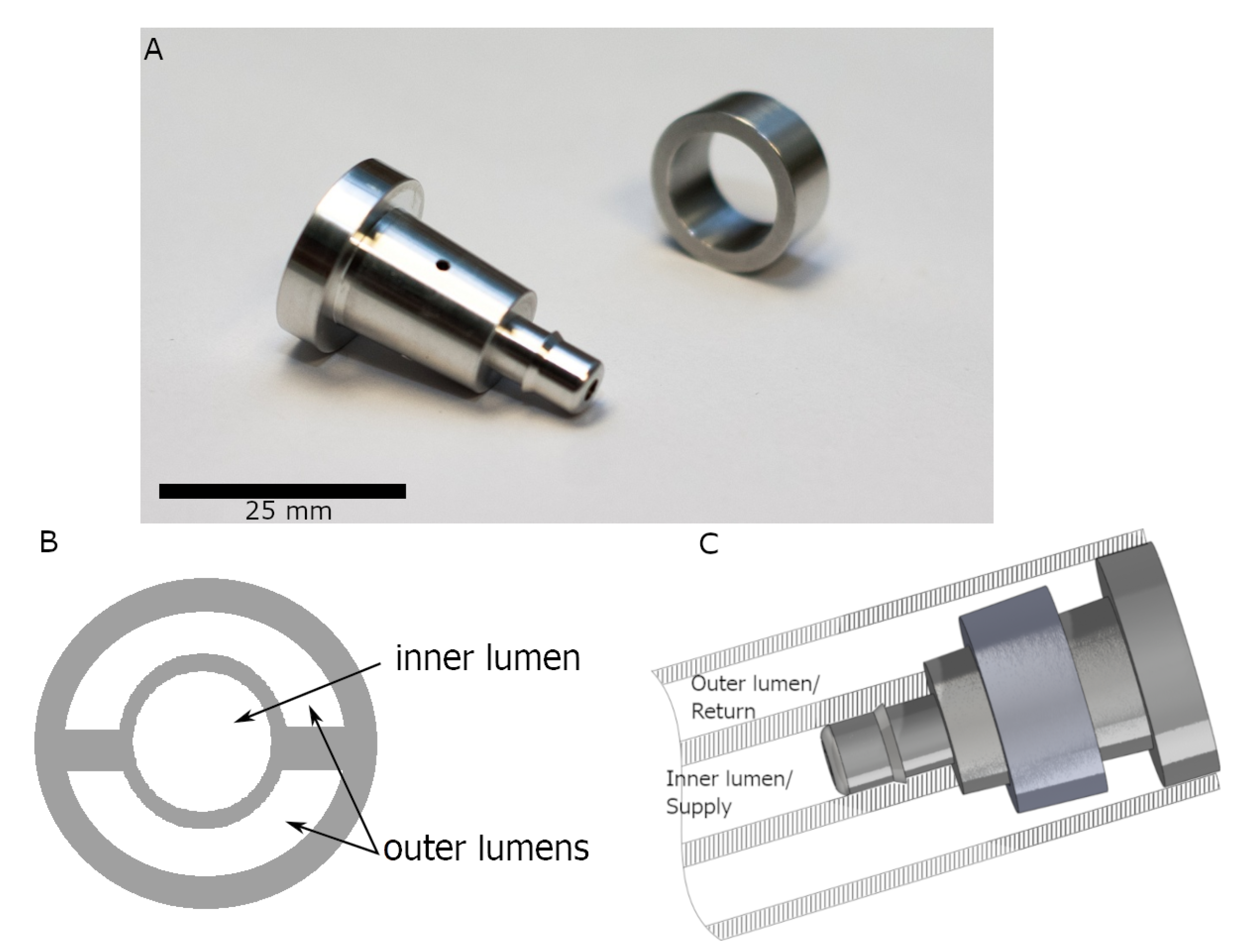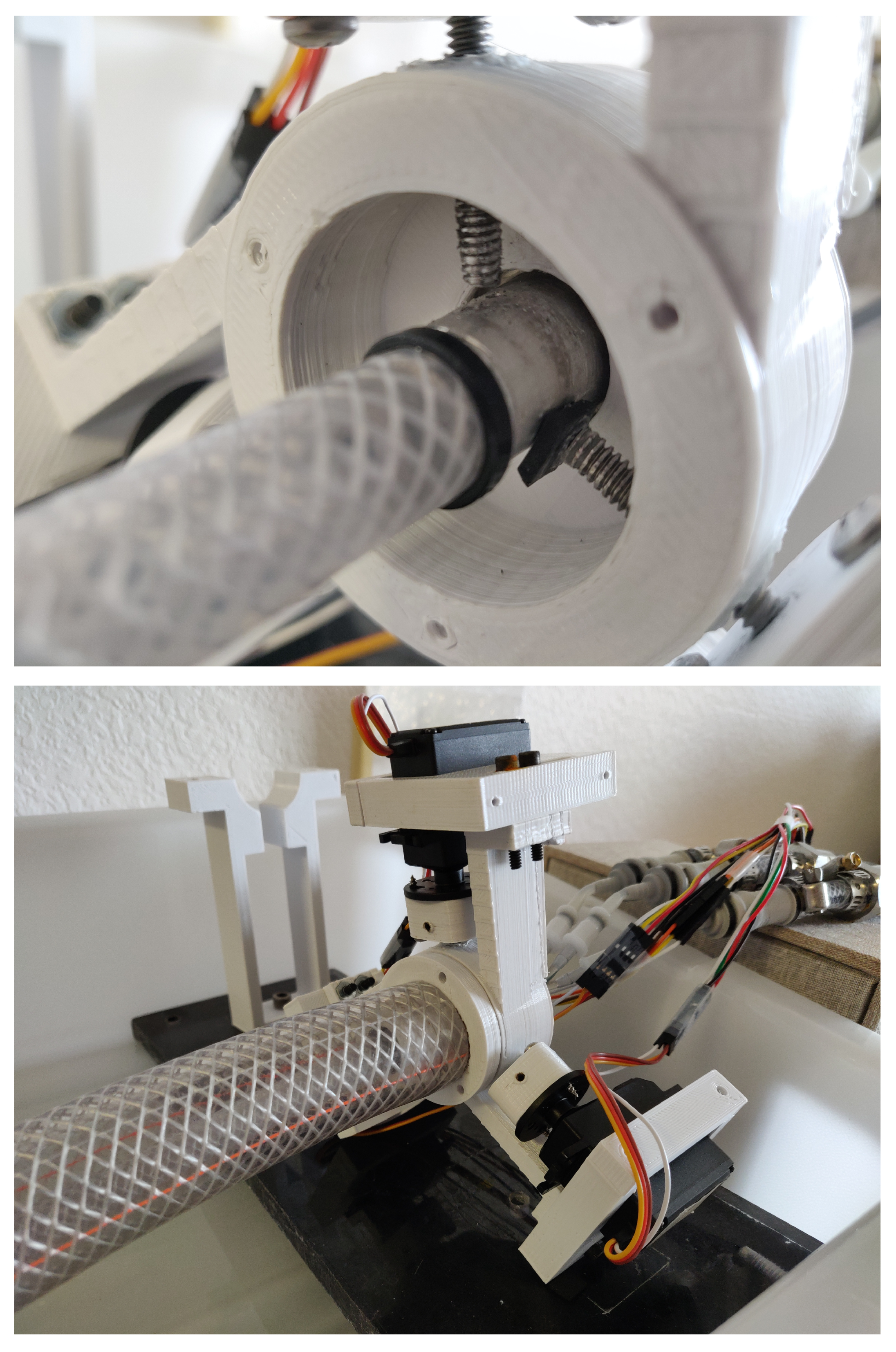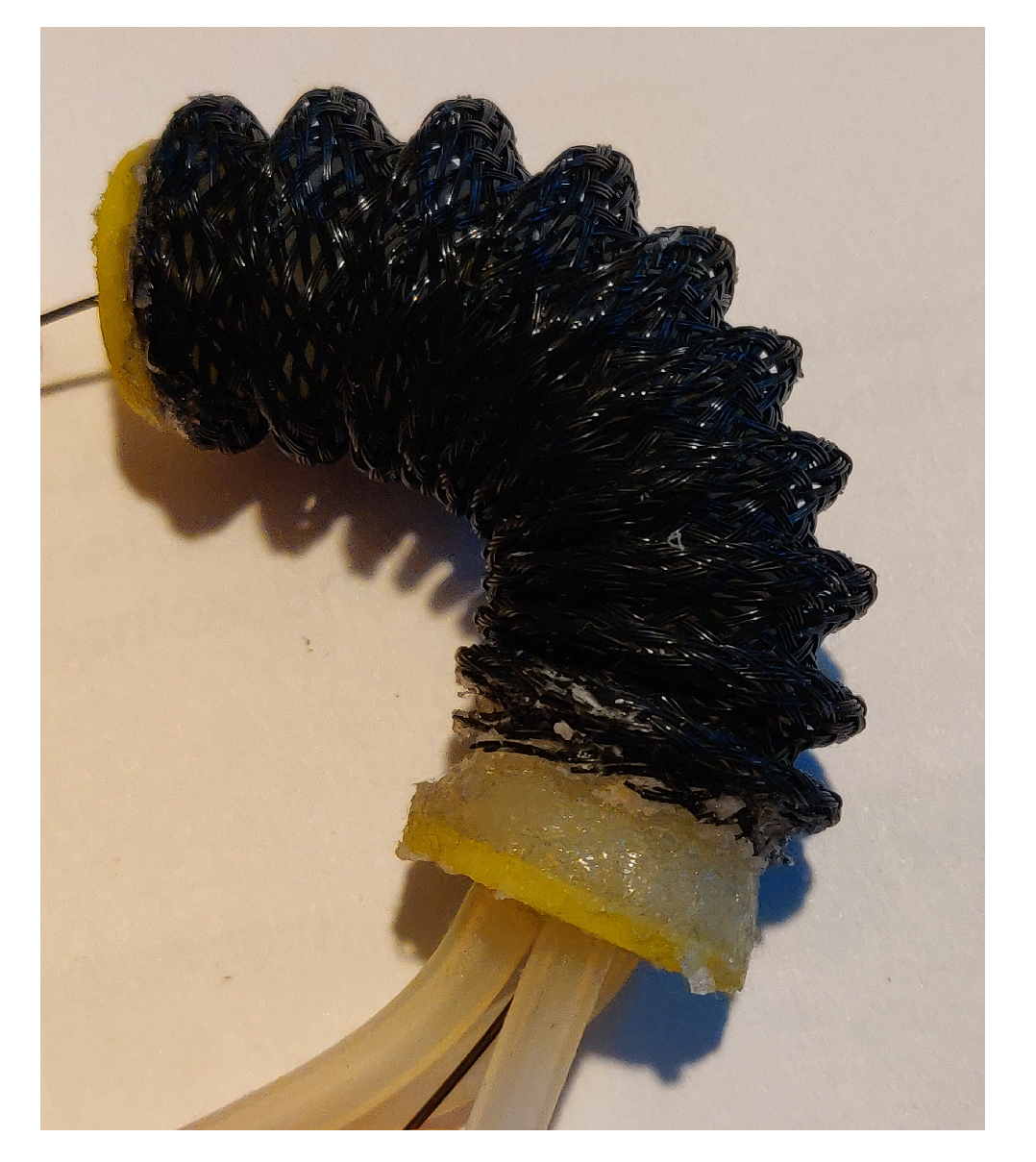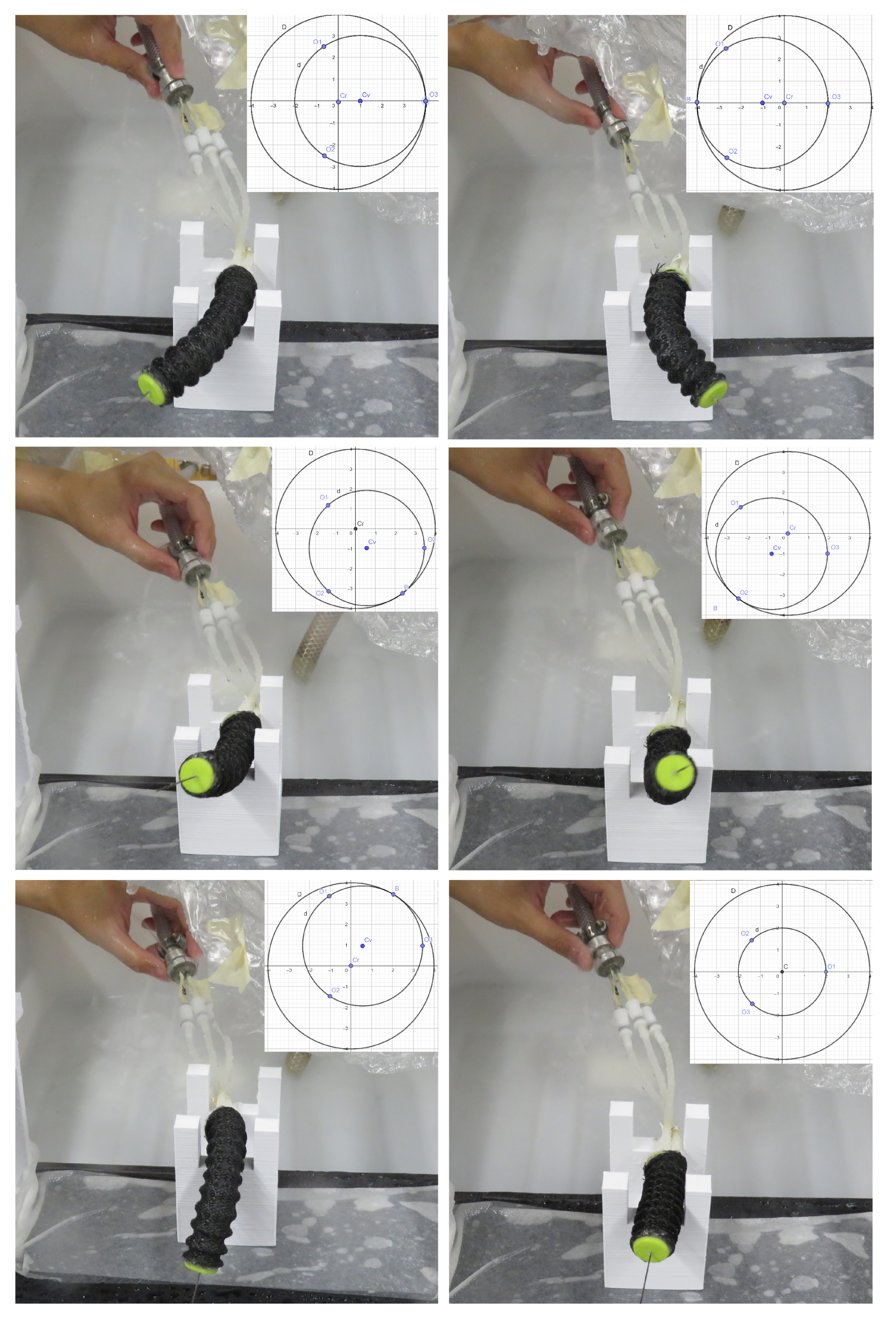A Novel 3D Ring-Based Flapper Valve for Soft Robotic Applications
Abstract
:1. Introduction
2. Control Valve Design
3. Description of Valve Realization
Relationship between Ring Geometry and Gap Distance
- Axial position, : This is the movement of the ring in and out of the plane of Figure 2C. Since the ring has a taper angle of and the minimum diameter is , the diameter of the ring at the plane of the nozzles is given by:
- Radial offset, or normalized offset, : The offset is the distance between the centers of the valve body and of the ring. We define to be the offset normalized by , which is the maximum possible offset for that axial position z. determines the maximum and minimum gap distances as the ring rotates, such that:
- Ring angle, : This is the angle between the line from the center of the valve body to the third orifice () and the extended line from the center of the ring to the center of the valve body (the extension of the segment ). The angle, , increases from as the ring rotates relative to the valve body in the anti-clockwise manner. See Figure 3A,B for two examples of ring positions.
4. Valve Prototype
5. Experimental Validation
5.1. Characterization of the Individual Orifice
5.2. Simulated Ring Manipulation
5.3. Manual Manipulation of the Physical Ring
5.4. Use of the Ring Valve for Soft-Robotic Control
6. Summary of Control Valve Design
7. Conclusions
Author Contributions
Funding
Institutional Review Board Statement
Informed Consent Statement
Data Availability Statement
Conflicts of Interest
References
- Homberg, B.S.; Katzschmann, R.K.; Dogar, M.R.; Rus, D. Robust proprioceptive grasping with a soft robot hand. Auton. Robot. 2019, 43, 681–696. [Google Scholar] [CrossRef] [Green Version]
- Runciman, M.; Darzi, A.; Mylonas, G.P. Soft robotics in minimally invasive surgery. Soft Robot. 2019, 6, 423–443. [Google Scholar] [CrossRef] [PubMed] [Green Version]
- George Thuruthel, T.; Ansari, Y.; Falotico, E.; Laschi, C. Control strategies for soft robotic manipulators: A survey. Soft Robot. 2018, 5, 149–163. [Google Scholar] [CrossRef] [PubMed]
- Bar-Cohen, Y.; Anderson, I.A. Electroactive polymer (EAP) actuators—Background review. Mech. Soft Mater. 2019, 1, 1–14. [Google Scholar] [CrossRef] [Green Version]
- Gu, G.; Shea, H.; Seelecke, S.; Alici, G.; Rizzello, G. From the Topic Editors: Soft Robotics based on Electroactive Polymers Authors. Front. Robot. AI 2021, 8, 122. [Google Scholar] [CrossRef]
- Padovani, D.; Barth, E.J. Design and Characterization of a Miniature Hydraulic Power Supply for High-Bandwidth Control of Soft Robotics. In Proceedings of the 2020 3rd IEEE International Conference on Soft Robotics (RoboSoft), New Haven, CT, USA, 15 May–15 July 2020; pp. 345–350. [Google Scholar]
- Park, T.; Kim, K.; Oh, S.R.; Cha, Y. Electrohydraulic actuator for a soft gripper. Soft Robot. 2020, 7, 68–75. [Google Scholar] [CrossRef] [PubMed]
- Love, L.; Lind, R.; Jansen, J. Mesofluidic actuation for articulated finger and hand prosthetics. In Proceedings of the 2009 IEEE/RSJ International Conference on Intelligent Robots and Systems, St. Louis, MO, USA, 10–15 October 2009; pp. 2586–2591. [Google Scholar]
- Ho, C.; Tai, Y. Micro-electro-mechanical-systems (MEMS) and fluid flows. Annu. Rev. Fluid Mech. 1998, 30, 579–612. [Google Scholar] [CrossRef] [Green Version]
- Whitesides, G. The origins and the future of microfluidics. Nature 2006, 442, 368–373. [Google Scholar] [CrossRef] [PubMed]
- Berg, D.R. Design of a Hydraulic Dexterous Manipulator for Minimally Invasive Surgery. Ph.D. Thesis, University of Minnesota, Minneapolis, MN, USA, 2013. [Google Scholar]
- Pourghodrat, A.; Nelson, C.A. Disposable fluidic actuators for miniature in-vivo surgical robotics. J. Med Devices 2017, 11, 011003. [Google Scholar] [CrossRef] [PubMed] [Green Version]
- Pourghodrat, A.; Nelson, C.A.; Oleynikov, D. Hydraulic Robotic Surgical Tool Changing Manipulator. J. Med Devices 2017, 11, 011008. [Google Scholar] [CrossRef] [PubMed] [Green Version]
- Linjama, M.; Vilenius, M. Digital hydraulics—Towards perfect valve technology. In Proceedings of the Tenth Scandinavian International Conference on Fluid Power, Tampere, Finland, 21–23 May 2007; Volume 1, pp. 181–196. [Google Scholar]
- Studer, V.; Hang, G.; Pandolfi, A.; Ortiz, M.; Anderson, W.; Quake, S. Scaling properties of a low-actuation pressure microfluidic valve. J. Appl. Phys. 2004, 95, 393–398. [Google Scholar] [CrossRef] [Green Version]
- Luque, A.; Quero, J.; Hibert, C.; Flückiger, P.; Gañán-Calvo, A. Integrable silicon microfluidic valve with pneumatic actuation. Sens. Actuators A Phys. 2005, 118, 144–151. [Google Scholar] [CrossRef]
- Baek, J.; Park, J.; Ju, J.; Lee, T.; Lee, S. A pneumatically controllable flexible and polymeric microfluidic valve fabricated via in situ development. J. Micromech. Microeng. 2005, 15, 1015–1020. [Google Scholar] [CrossRef]
- Selvaganapathy, P.; Carlen, E.; Mastrangelo, C. Electrothermally actuated inline microfluidic valve. Sens. Actuators A Phys. 2003, 104, 275–282. [Google Scholar] [CrossRef]
- Huff, M.; Mettner, M.; Lober, T.; Schmidt, M. A pressure-balanced electrostatically-actuated microvalve. In Proceedings of the IEEE Solid-State Sensor and Actuator Workshop, 4th Technical Digest, Hilton Head, SC, USA, 4–7 June 1990; pp. 123–127. [Google Scholar]
- Sounart, T.; Michalske, T. Electrostatic actuation without electrolysis in microfluidic MEMS. In Proceedings of the 12th International Conference on Transducers, Solid-State Sensors, Actuators and Microsystems, Boston, MA, USA, 8–12 June 2003; pp. 615–618. [Google Scholar]
- Ohnstein, T.; Fukiura, T.; Ridley, J.; Bonne, U. Micromachined silicon microvalve. In Proceedings of the IEEE Conference on Micro Electro Mechanical Systems, Napa Valley, CA, USA, 11–14 February 1990; pp. 95–98. [Google Scholar]
- Fikru, N.; Chase, T. A review of MEMS based pneumatic valves. In Proceedings of the 2011 52nd National Conference on Fluid Power, Beijing, China, 7–20 August 2011; pp. 271–282. [Google Scholar]
- Fu, C.; Rummler, Z.; Schomburg, W. Magnetically driven micro ball valves fabricated by multilayer adhesive film bonding. J. Micromech. Microeng. 2003, 13, S96. [Google Scholar] [CrossRef]
- Pernod, P.; Preobrazhensky, V.; Merlen, A.; Ducloux, O.; Talbi, A.; Gimeno, L.; Viard, R.; Tiercelin, N. MEMS magneto-mechanical microvalves (MMMS) for aerodynamic active flow control. J. Magn. Magn. Mater. 2010, 322, 1642–1646. [Google Scholar] [CrossRef]
- Peirs, J. Design of miniature parallel manipulators for integration in a self-propelling endoscope. Sens. Actuators A Phys. 2000, 85, 409–417. [Google Scholar] [CrossRef]
- Schulte, H. The characteristics of the McKibben artificial muscle. In The Application of External Power in Prosthetics and Orthotics; National Academy of Sciences—National Research Council: Washington, DC, USA, 1961; pp. 94–115. [Google Scholar]
- Webster III, R.J.; Jones, B.A. Design and kinematic modeling of constant curvature continuum robots: A review. Int. J. Robot. Res. 2010, 29, 1661–1683. [Google Scholar] [CrossRef]
- Merritt, H. Hydraulic Control Systems; John Wiley & Sons Inc.: Hoboken, NJ, USA, 1967. [Google Scholar]
- Berg, D.R. Ring valve design files. Figshare 2017. [Google Scholar] [CrossRef]
- Falco, I.D. Soft Robotics Toolkit: Multi-Module Variable Stiffness Manipulator. Available online: https://softroboticstoolkit.com/mmvsm (accessed on 30 January 2021).









Publisher’s Note: MDPI stays neutral with regard to jurisdictional claims in published maps and institutional affiliations. |
© 2021 by the authors. Licensee MDPI, Basel, Switzerland. This article is an open access article distributed under the terms and conditions of the Creative Commons Attribution (CC BY) license (https://creativecommons.org/licenses/by/4.0/).
Share and Cite
Low, K.; Berg, D.R.; Li, P.Y. A Novel 3D Ring-Based Flapper Valve for Soft Robotic Applications. Robotics 2022, 11, 2. https://doi.org/10.3390/robotics11010002
Low K, Berg DR, Li PY. A Novel 3D Ring-Based Flapper Valve for Soft Robotic Applications. Robotics. 2022; 11(1):2. https://doi.org/10.3390/robotics11010002
Chicago/Turabian StyleLow, Kelly, Devin R. Berg, and Perry Y. Li. 2022. "A Novel 3D Ring-Based Flapper Valve for Soft Robotic Applications" Robotics 11, no. 1: 2. https://doi.org/10.3390/robotics11010002





